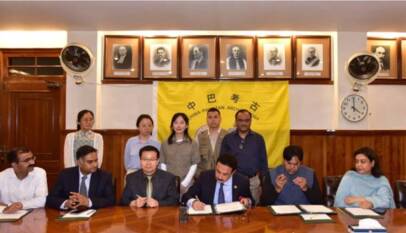Australian cargo ships docks at Gwadar Port
An Australian cargo ship,Seaken-Mv docked in Gwadar Port, carrying 21,000 tonnes of urea. Earlier last week, the Chairman CPEC Authority, retired Lt Gen Asim Saleem Bajwa announced that the Gwadar deep sea port had become functional for big cargo ships, carrying import and export goods. Officials at the port have said these activities will create ample job opportunities for locals.
The geopolitics of the Eurasian Heartland are gradually being reshaped by the BRI-backed Afghan-Pakistani rapprochement. Ties between these neighbouring nations have always been complicated for historical reasons, but Kabul appears ready to behave more pragmatically as it seeks to chart a new era of relations with Islamabad in the wake of the US’ impending withdrawal from the country by September 11th. Their Foreign Ministers joined China’s last week in their fourth trilateral meeting that was held online this year because of the Covid-19 pandemic. The joint statement that resulted from their talks emphasised Afghanistan’s enhanced regional connectivity through its use of CPEC’s terminal port of Gwadar.
This speaks to the landlocked country’s desire to become land-linked via the Belt & Road Initiative’s (BRI) flagship project, which in turn is responsible for Afghanistan’s pragmatic policy recalibration towards Pakistan. In other words, BRI isn’t just connecting economies, but governments, as each of its participating states has a mutual interest in repairing whatever strained relations they may have with one another in order to mutually benefit from this global series of megaprojects. Moreover, Afghanistan’s increased reliance on CPEC proves the viability of the N-CPEC+ proposal for expanding this corridor further northwards deeper into Central Asia through the trilateral railway that’s planned between them and Uzbekistan (PAKAFUZ).
Another pertinent observation is that Afghanistan is seemingly no longer all that interested in Iran’s Indian-controlled port of Chabahar that New Delhi had initially envisioned functioning as that country’s corridor to the sea. Kabul will likely use it to some extent, but it’s unrealistic to expect it to trade more across that corridor than across N-CPEC+, especially once the PAKAFUZ railway is completed. This throws a wrench in India’s regional engagement plans, but it might be for the better since New Delhi could prospectively seek to retain stable relations with Islamabad so as to more reliably access Afghanistan via their mutual neighbour. That’s actually what Pakistani officials suggested in March when they unveiled their country’s new grand strategy.
The best-case scenario of improved Indian-Pakistani ties is probably still a ways off considering their unresolved dispute over Kashmir’s final political status and Prime Minister Imran Khan’s recent statement that such normalisation of relations is impossible until New Delhi restores the region’s autonomy. Nevertheless, this doesn’t mean that pragmatic bilateral and multilateral (i.e. including Afghanistan) economic engagement can’t occur, but it’ll still require considerable political will from all players in order to succeeded. In addition, India might feel uncomfortable trading with Afghanistan across a corridor that’s referred to as N-CPEC+, hence the possible need to rebrand it as something more neutral such as the “Central Eurasian Corridor” (CEC).
Semantics aside, it’s unclear whether that scenario will come to pass in the coming future considering the political complexities involved, but it’s much more obvious that India will definitely have to recalibrate its regional approach to Central Asia in light of Afghanistan’s increased cooperation with CPEC at Chabahar’s perceived expense. That Iranian port was also supposed to function as a key node in the North-South Transport Corridor (NSTC) that’s envisioned as stretching all the way north to Russia, but the project has been mostly stillborn since India voluntarily decided to comply with the US’ unilateral sanctions against the Islamic Republic. Should they be lifted as part of a revised nuclear deal, then the project might finally be revived.
Even in that event, however, India and its pertinent partners would have still lost a lot of time since Afghanistan’s incorporation into CPEC is irreversible. The NSTC will therefore likely fail to meet the lofty expectations that were originally held of it, especially with respect to serving as India’s entry point to Central Asia. That’s not to say that the project will be a complete failure since it’ll probably still be used in some capacity or another, but just that India might either have to abandon its hopes of “balancing” China in this geostrategic space via the NSTC or seriously explore a rapprochement with Pakistan in order to guarantee reliable access to Central Asia. Neither policy option is what India initially envisioned doing.
Regardless of whatever course of action it ultimately decides upon, it’s clear that the BRI-backed Afghan-Pakistani rapprochement is reshaping regional geopolitics by mitigating Indian influence in Central Asia. India might even accept that it’ll probably be unable to become a mainland Eurasian power like it wanted and instead focus more on what it describes as the Indo-Pacific in order to become a maritime one. That might arguably be more of a pragmatic policy since it’s practically impossible for India to make up its lost ground in Central Asia after what just recently happened even if it doesn’t abandon this part of the world outright. Concentrating more on East Africa, Southeast Asia, and Russia’s Arctic & Far Eastern regions might be a better choice.
With India potentially bowing out of the Great Power competition in Central Asia, the only realistic extra-regional “balancing” partner left for those five countries is Turkey, which is making strides in the region through its “Middle Corridor”. Ankara’s relations with the Russian-Chinese duopoly jointly managing Central Asian affairs at the moment are somewhat complicated though the West Asian country has recently behaved much more pragmatically with both of them than in time’s past despite concerns over Turkish drone sales to the Polish-led anti-Russian “Lublin Triangle” and Turkey’s interest in China’s Uyghur minority. Nevertheless, it’s unlikely that Turkey would try to disrupt the state of affairs in Central Asia since it benefits from stability there.
The end result of the BRI-backed Afghan-Pakistani rapprochement is that Turkey might soon become a more serious extra-regional player in Central Asia than India since the latter seems to have lost out on its opportunity for comprehensive regional engagement via Chabahar. The South Asian state might also be encouraged by these dynamics to seriously consider a meaningful rapprochement with Pakistan which would in that case require some tough compromises on Kashmir. The broader region’s geopolitics are therefore being reshaped, though it’s not yet clear what the outcome will be. In any case, the observable trend is a positive one which will contribute to Eurasian stability if it remains in effect as is expected.
PU and Chinese academy join hands for archaeological research under CPEC framework
LAHORE:Punjab University’s Department of Archaeology and Institute of Archaeology Ch…












